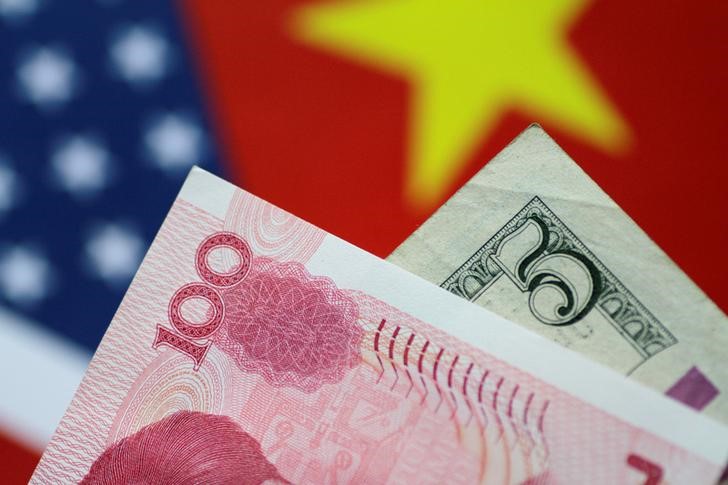Forex
Asia FX dips on Fed concerns, Chinese yuan sees intervention support


© Reuters.
Investing.com — Most Asian currencies fell on Thursday after the minutes of the Federal Reserve’s July meeting presented a hawkish outlook on interest rates, while the Chinese yuan rose amid reports of currency market intervention by the state.
The dollar strengthened against a basket of currencies after the , coming within sight of an over two-month high as traders bet that U.S. interest rates will remain , or even potentially rise further this year.
This notion pressured most Asian currencies, as the gap between risky and low-risk yields narrowed. The was among the worst hit, hovering at a nine-month low on Thursday.
Data also showed that Japan logged a surprise in July, while the country’s , particularly to China, contracted for the first time since 2021.
Weak trade data also weighed on the , with the currency losing 0.2% after the island state’s key shrank more than expected in July.
Singapore’s trade activity acts as a bellwether for broader Asia, and heralds continued weakness due to slowing demand in China.
The slid 0.6%, hitting a nine-month low on risks from a Chinese slowdown. Data also showed some cooling in Australia’s through July, which gives the Reserve Bank less impetus to keep raising interest rates.
Chinese yuan recovers from 9-mth low amid intervention reports
The was among the few outliers for the day, surging 0.7% from its weakest level since November 2022.
that China’s major state-owned banks were seen selling U.S. dollars to snap up yuan in both onshore and offshore spot markets this week, with the measures aimed chiefly at buoying the Chinese currency.
The yuan was nursing steep losses for August as a string of readings pointed to worsening conditions in the world’s second-largest economy.
Fears of a brewing debt crisis in China’s property market also weighed on the yuan, as markets feared contagion from a potential default by major real estate developer Country Garden Holdings (HK:).
Fitch Ratings , especially if the government stretches its debt levels to help buoy the economy. But the ratings agency sees few chances of this happening in the near-term.
The was also among the few outliers for the day, rising 0.3% amid reports that the Reserve Bank was selling dollars to keep the Indian currency off record lows.
Fed minutes boost dollar, U.S. rate outlook in focus
The and rose 0.1% each in Asian trade, and were close to their strongest levels since early-June.
The minutes of the Fed’s July meeting showed on Wednesday that most members of the rate-setting committee supported more interest rate hikes to curb sticky inflation.
The minutes added to concerns over rising U.S. interest rates, especially after read higher in July. The Fed had in July, and had warned that further increases were contingent on the path of inflation.

 Forex3 years ago
Forex3 years agoForex Today: the dollar is gaining strength amid gloomy sentiment at the start of the Fed’s week

 Forex3 years ago
Forex3 years agoUnbiased review of Pocket Option broker

 Forex3 years ago
Forex3 years agoDollar to pound sterling exchange rate today: Pound plummeted to its lowest since 1985

 Forex3 years ago
Forex3 years agoHow is the Australian dollar doing today?

 Cryptocurrency3 years ago
Cryptocurrency3 years agoWhat happened in the crypto market – current events today

 World3 years ago
World3 years agoWhy are modern video games an art form?

 Commodities3 years ago
Commodities3 years agoCopper continues to fall in price on expectations of lower demand in China

 Economy3 years ago
Economy3 years agoCrude oil tankers double in price due to EU anti-Russian sanctions


























